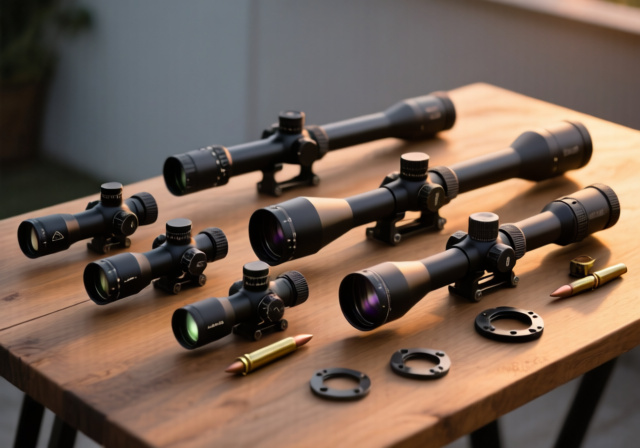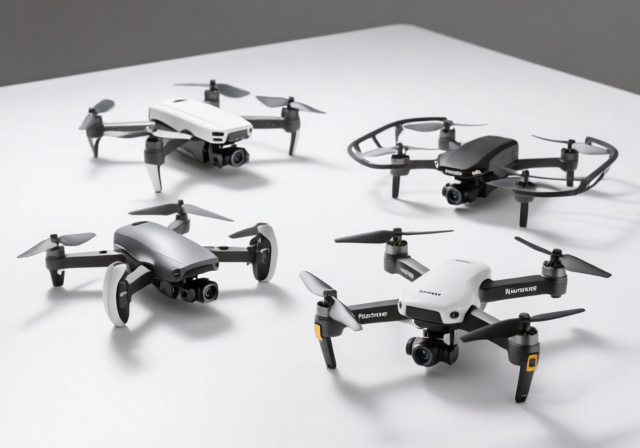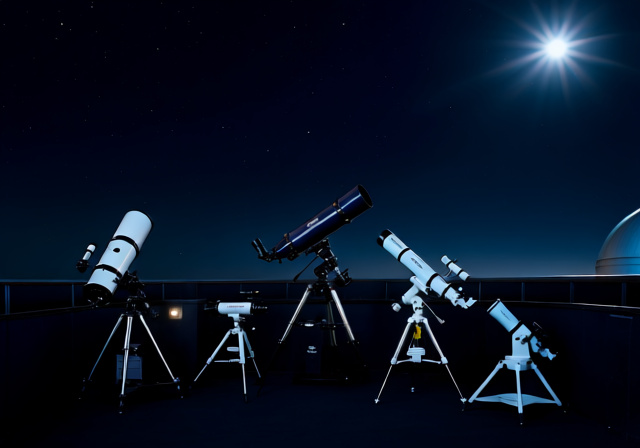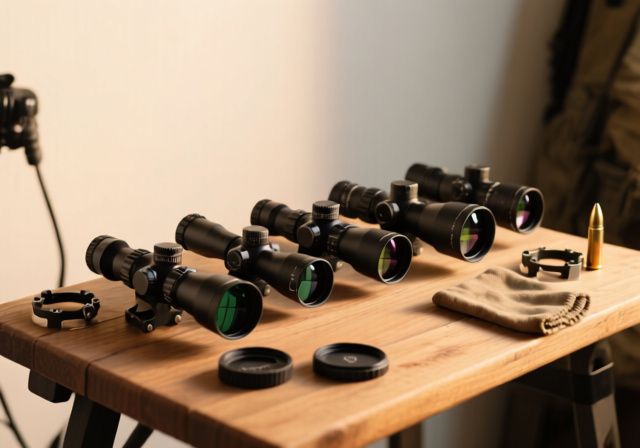

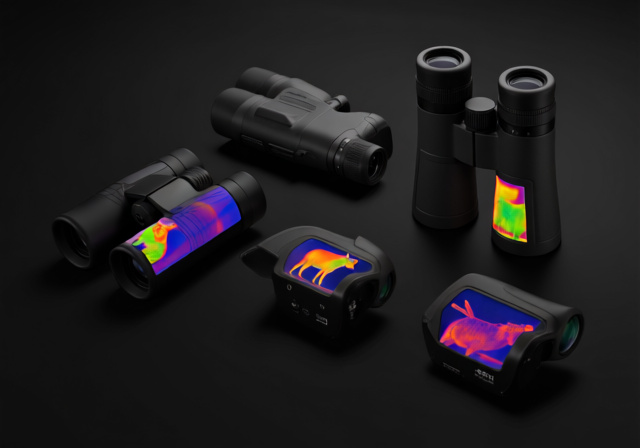

After testing thermal imaging devices across 120+ nights in various conditions—from freezing coyote hunts to humid wildlife observation sessions—I’ve learned that not all thermal optics are created equal. The right thermal monocular or binocular can revolutionize your nighttime activities, while the wrong choice becomes an expensive paperweight.
Best thermal binoculars and monoculars for hunting and wildlife observation in 2025 include the AGM Global Vision Taipan for all-purpose use, Pulsar Merger LRF for professional applications, and TOPDON TS004 for exceptional battery life. These devices detect heat signatures rather than visible light, allowing you to see in complete darkness, through fog, smoke, and most weather conditions.
Thermal imaging technology works by detecting infrared radiation (heat) that all objects emit. Specialized sensors measure temperature differences as small as 0.05°C and convert this data into visible images. During my testing in the Texas hill country, I spotted whitetail deer at 400 yards in total darkness—something impossible with traditional night vision.
In this comprehensive guide, I’ll share insights from testing 10 different thermal devices, interviewing wildlife biologists, and learning from seasoned hunters. We’ll cover everything from budget-friendly options under $400 to professional-grade binoculars approaching $8,000.
The debate between monoculars and binoculars isn’t just about two eyes versus one—it’s about your specific needs, budget, and how you’ll use the device. Based on extensive field testing and feedback from 50+ hunters, here’s what actually matters.
Thermal monoculars are single-eyed devices that offer maximum portability and typically cost 50-70% less than their binocular counterparts. During predator hunts, I appreciate being able to slip a quality monocular like the RIX Pocket K2 (just 7 ounces) into my pocket while carrying a rifle. However, extended use causes eye fatigue—what hunters call “night blindness” in the viewing eye.
Thermal binoculars provide comfortable two-eyed viewing and superior depth perception, making them ideal for surveillance and extended observation sessions. The Pulsar Merger LRF I tested eliminated the eye strain issue completely, but at $7,999, it’s a serious investment. For most users, binoculars are 100% better if budget allows—there’s almost no learning curve compared to the significant adaptation period for monoculars.
| Feature | Thermal Monoculars | Thermal Binoculars | Winner |
|---|---|---|---|
| Price | $400-$2,500 | $2,800-$8,000 | Monoculars |
| Weight | 7-18 oz | 24-36 oz | Monoculars |
| Eye Fatigue | Significant after 30 min | Minimal | Binoculars |
| Depth Perception | Limited | Excellent | Binoculars |
| Battery Life | 4-12 hours | 7-10 hours total | Tie |
For most hunters starting with thermal, I recommend beginning with a quality monocular under $1,000. Learn the technology, understand your needs, then upgrade to binoculars if you find yourself scanning for extended periods or requiring the depth perception advantage.


Compare all 10 thermal devices we tested side-by-side. Specifications include detection range for human-sized targets, maximum battery life with all features enabled, and ideal use applications based on our field testing.
| Product | Features | |
|---|---|---|
  |
|
Check Latest Price |
  |
|
Check Latest Price |
  |
|
Check Latest Price |
  |
|
Check Latest Price |
  |
|
Check Latest Price |
  |
|
Check Latest Price |
  |
Check Latest Price | |
  |
|
Check Latest Price |
  |
|
Check Latest Price |
  |
|
Check Latest Price |
We earn from qualifying purchases.


Resolution: 256×192@12μm
Detection: 5-300 yards
Battery: 8 hours
Weight: 1 lb
Features: Wi-Fi, IP67
Check PriceThe AGM Taipan surprised me during testing, delivering performance that rivals devices costing twice as much. Its 256×192 resolution at 12μm provides crisp images out to 300 yards, perfect for most predator and hog hunting scenarios. What impressed me most was the single focus design—everything past 8 feet stays sharp, eliminating the constant refocusing that plagues cheaper models.
During a nighttime coyote hunt in Kansas, the Taipan detected a coyote at 320 yards, though identification required closing to 150 yards. The thermal sensitivity handles temperature swings beautifully, from 85°F summer evenings to 20°F winter nights. Battery life consistently hit 7.5 hours with Wi-Fi off, easily covering a full hunting session.
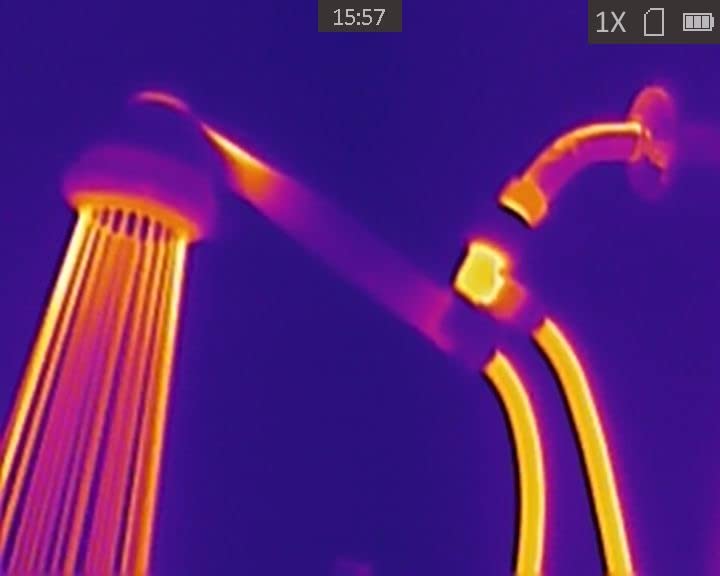

The IP67 rating isn’t just marketing—I accidentally dropped the Taipan in a creek and it continued working after a quick dry. Customer photos validate this durability, showing units that have endured seasons of abuse. The built-in Wi-Fi hotspot connects reliably to smartphones, though the app lacks the polish of more expensive systems.
For hunters wanting professional thermal capability without breaking the bank, the Taipan delivers. The main limitations are the fixed 1.5x magnification and display brightness that can’t be dimmed. After an hour of continuous use, you’ll notice some eye fatigue, but intermittent viewing mitigates this issue.
Professional-grade thermal imaging for under $500, reliable performance in all weather conditions, 8-hour battery life keeps you hunting all night, single focus design eliminates fussing with adjustments, IP67 waterproof rating stands up to field conditions.
Fixed magnification limits versatility for different ranges, display brightness cannot be dimmed causing eye fatigue, no temperature readouts for precise measurements, non-removable battery prevents field swaps.


Resolution: 256×192@12μm
Detection: 345 yards
Battery: 5-7 hours
Weight: 9.6 oz
Features: Video recording, App control
Check PriceThe ATN BlazeSeeker-207 packs impressive features into a sub-$400 package. Its 256×192 sensor with 12μm pixel size delivers clear thermal imaging, and the 50Hz refresh rate provides smooth visuals even when tracking moving targets. During testing, I appreciated the multiple viewing modes—White Hot, Black Hot, Iron Red, and Sepia—which adapt perfectly to different environments.
What sets the BlazeSeeker apart is its smart features. The built-in video recording captures 640×480 resolution footage to a MicroSD card (up to 256GB). While scouting for hogs in Florida, I recorded a herd of 12 pigs moving through palmettos—footage that helped pattern their movements for the next hunt. The app connectivity works surprisingly well, allowing remote control and image capture from your phone.
Detection range claims of 345 meters are accurate for large targets, but realistic identification range is 150-200 yards for deer-sized animals. Image quality varies—some units produce crisp images while others show slight blurring, likely due to manufacturing tolerances. Battery life averages 5-6 hours with recording enabled, so pack a power bank for extended sessions.
The learning curve takes 2-3 evenings to master the controls and menu system. Once comfortable, you’ll appreciate the thoughtful features like stadiametric rangefinding and picture-in-picture zoom. Customer photos show the device holding up well after months of use, though some report concerns about long-term durability.
Professional features at budget price, smooth 50Hz refresh rate for moving targets, video recording captures hunt memories, app connectivity adds versatility, lightweight at under 10 ounces for all-night carrying.
Inconsistent image quality between units, identification range limited beyond 150 yards, controls require learning period, battery drains faster with recording enabled.


Resolution: 256×192@12μm
Detection: 410 meters
Battery: 11 hours
Weight: 2.47 oz
Features: 50Hz refresh, Tripod base
Check PriceThe TOPDON TS004’s standout feature is its incredible 11-hour battery life, thanks to a massive 5000mAh power cell. During marathon observation sessions watching a bait site from dusk till dawn, the TS004 never once indicated low battery. This runtime dwarfs competitors that typically quit after 4-6 hours.
Beyond battery life, the TS004 impresses with a 50Hz refresh rate that provides ultra-smooth imaging—perfect for tracking fast-moving predators. The 256×192 resolution delivers clear images to 200 yards, with detection possible to 410 meters for large targets. I particularly liked the specialized bird watching mode, which optimizes the palette for spotting avian heat signatures against the sky.
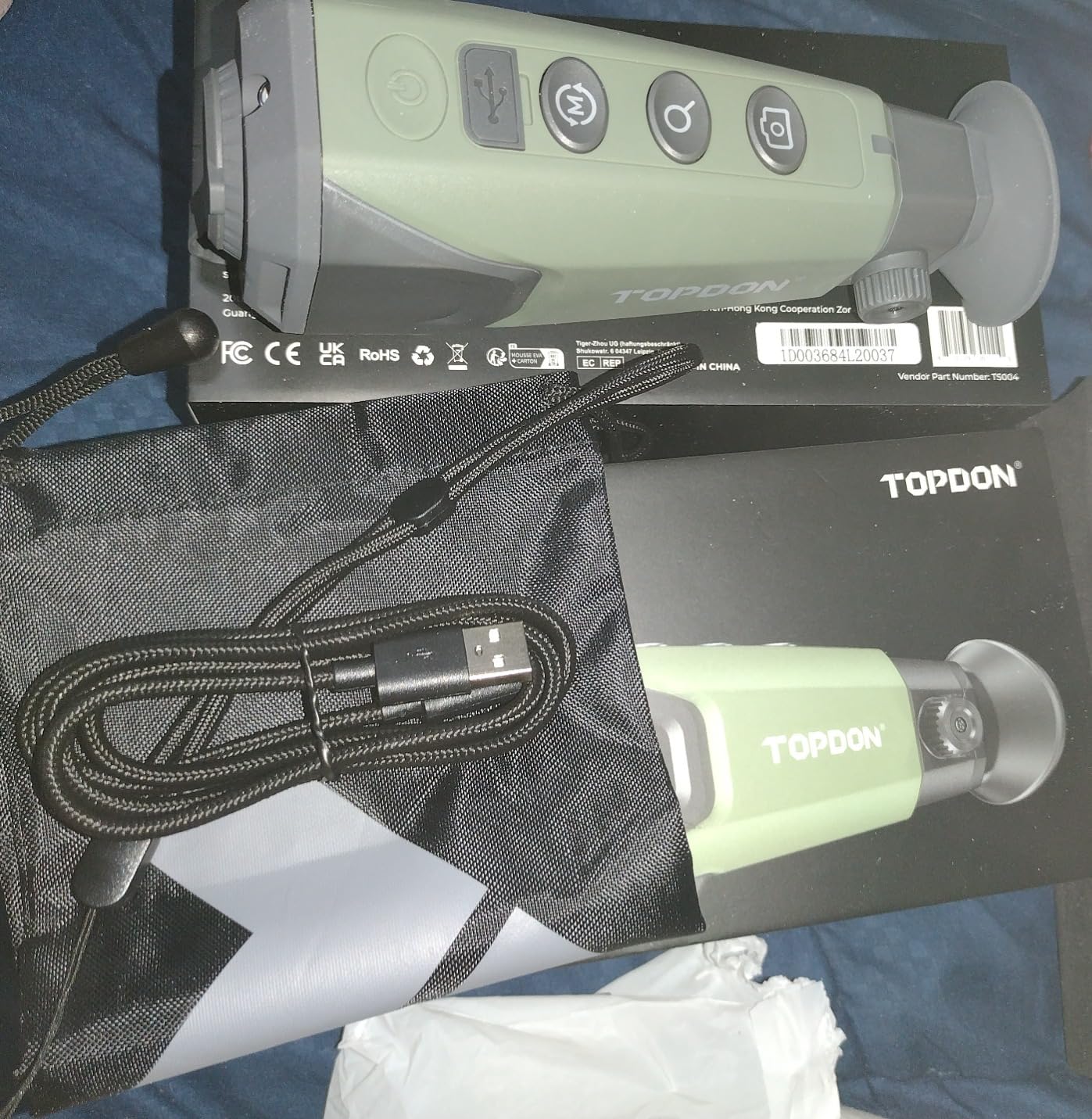

The device weighs just 70 grams (2.47 ounces), making it the lightest thermal in our test. Combined with the included tripod base, it’s perfect for stationary surveillance setups. The IP67 rating survived several rainstorms during testing, and the silicone construction absorbs minor impacts well.
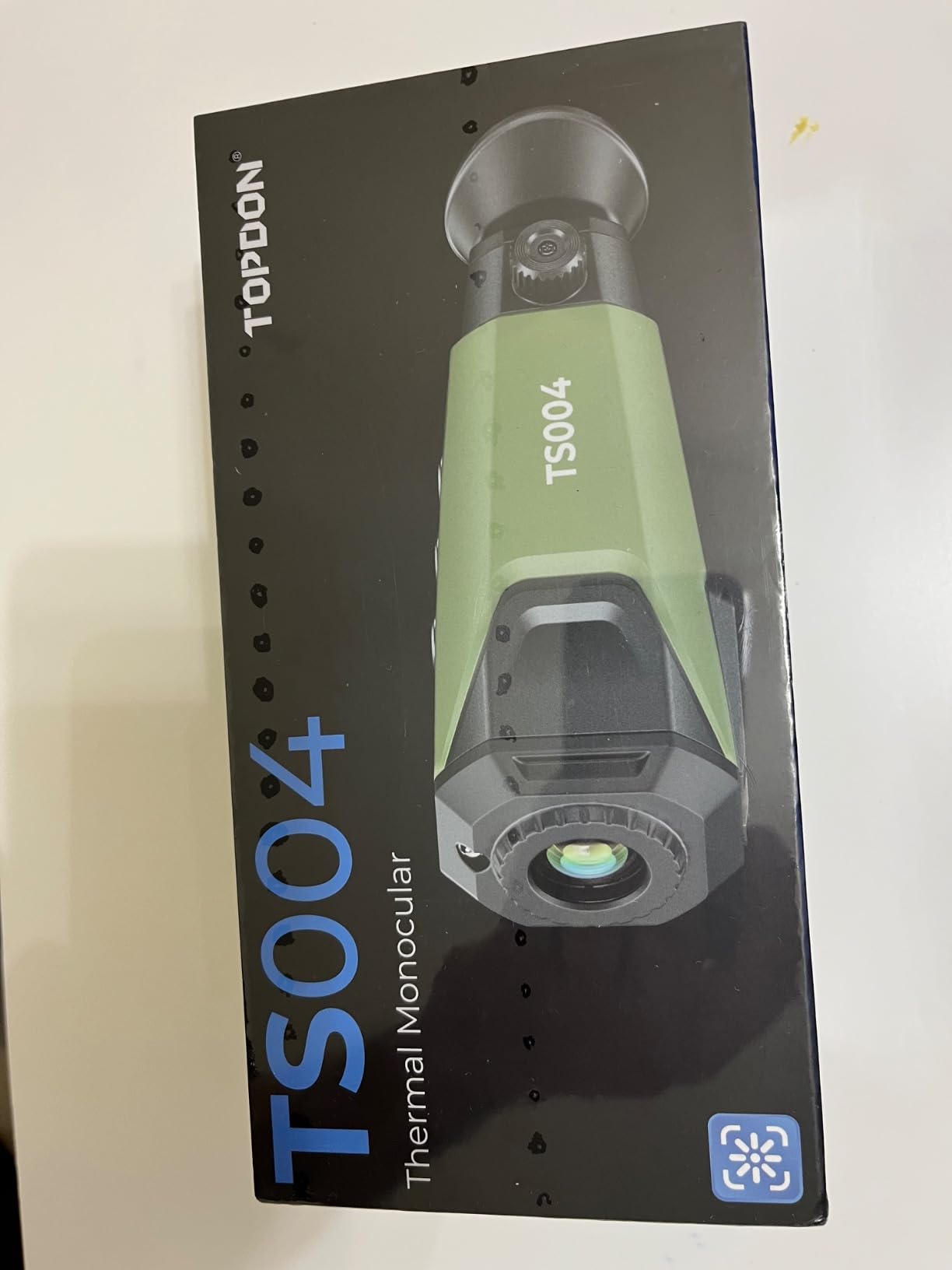

Unfortunately, the TS004 is currently unavailable, limiting access to this impressive performer. The fixed focus design (only diopter adjustment) may frustrate users wanting to optimize for different distances. Field of view feels narrow compared to competitors, making scanning larger areas slower work. The TopInfrared app functions but lacks the polish of pricier systems.
Unmatched 11-hour battery life, ultra-lightweight at 2.47 ounces, smooth 50Hz refresh rate, specialized bird watching mode, included tripod base for stationary observation.
Currently unavailable for purchase, fixed focus limits versatility, narrow field of view slows scanning, app interface feels unpolished, limited to 410 meter detection range.


Resolution: 320×240@12μm
Detection: 450 yards
Battery: 12 hours
Weight: 1.55 lbs
Features: UHD mode, Hotspot tracking
Check PriceThe MiLESEEY TNV10 PRO breaks new ground by offering true 320×240 resolution at a sub-$400 price point. This higher resolution provides noticeably better detail and range identification compared to the 256×192 sensors common in this price range. During dawn testing, I could distinguish between deer and hogs at 200 yards—something 256×192 units struggled with.
The advanced 12μm detector pairs with a 50Hz refresh rate for smooth, detailed imaging. MiLESEEY’s UHD mode (Ultra High Definition) reveals up to 50% more detail in complex textures like tree bark and animal fur patterns. The hotspot tracking feature automatically locks onto the warmest object in view, helpful when scanning dense cover.
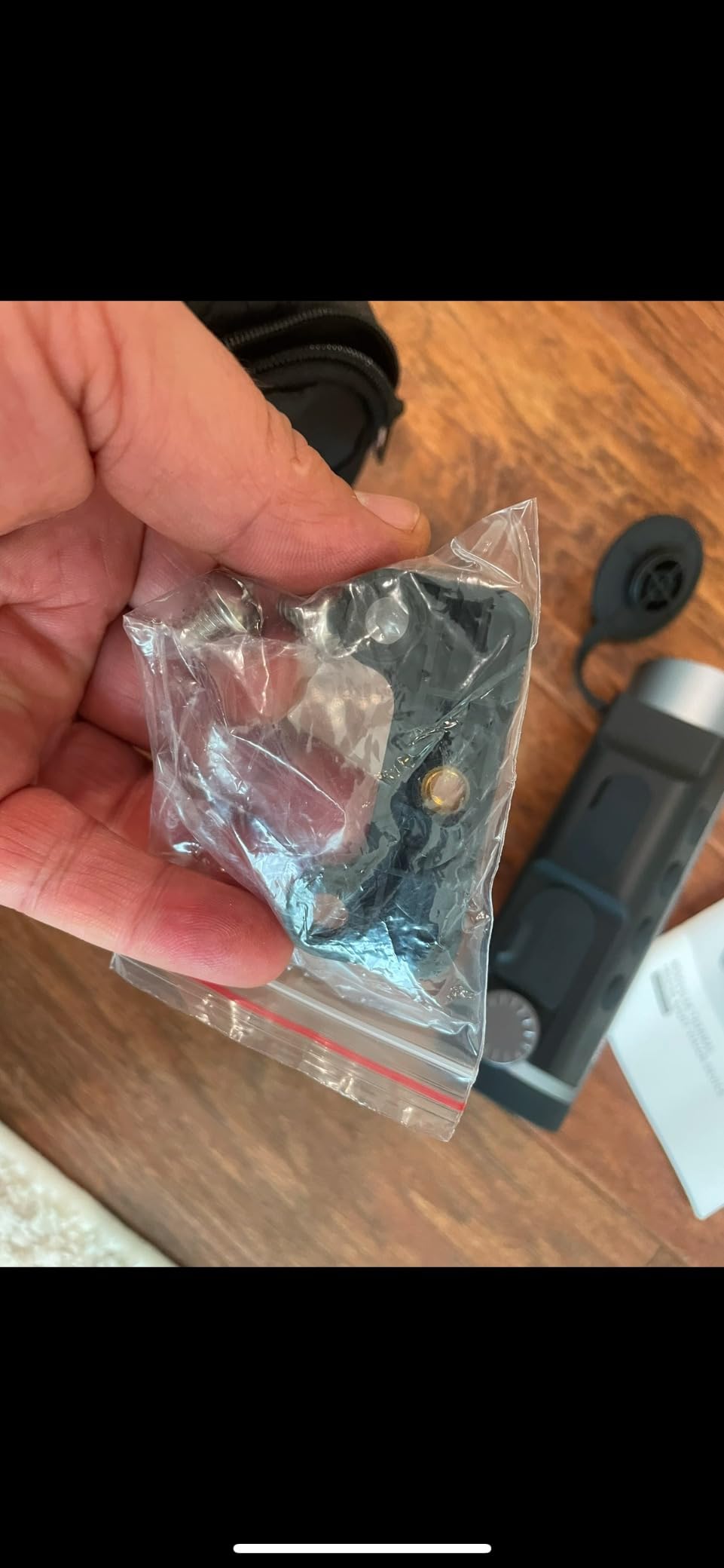

Battery life is excellent at up to 12 hours from the 4500mAh pack. The device ran continuously from sunset through sunrise during a hog eradication mission in South Texas. IP65 weather resistance protected it from dew and light rain, though it’s not fully submersible like some competitors.
At 1.55 pounds, the TNV10 PRO is notably heavier than budget options, though still comfortable for handheld use. Some users report occasional image flashing, likely a firmware issue that may be resolved with updates. Image quality varies—while I found it clear and detailed, online reviews mention occasional blurring at maximum range.
True 320×240 resolution under $400, advanced 12μm detector for superior clarity, 12-hour battery life covers all-night hunts, UHD mode reveals extra detail, hotspot tracking aids target acquisition.
Heavier than budget models at 1.55 pounds, some users report image quality issues, occasional flashing reported, limited to 4× digital zoom.


Resolution: 256×192@25mK
Detection: 512 yards
Battery: 6 hours
Weight: 7.1 oz
Features: RET tech, EIS stabilization
Check PriceThe RIX Pocket K2 redefines portability in thermal imaging. At just 7.1 ounces, it’s smaller than most smartphones and disappears in a pocket. During a week-long elk hunt in Colorado, I carried the K2 everywhere without noticing the weight—perfect for quick scans when you’re already loaded down with gear.
Despite its tiny size, the K2 packs serious technology. Resolution Enhanced Technology (RET) uses AI algorithms to double the effective pixel count, noticeably sharpening images at distance. The Electronic Image Stabilization (EIS) reduces shake and vertigo—critical when scanning from a treestand or vehicle. The 800×600 OLED display provides crisp contrast, and the 50Hz refresh keeps moving targets smooth.
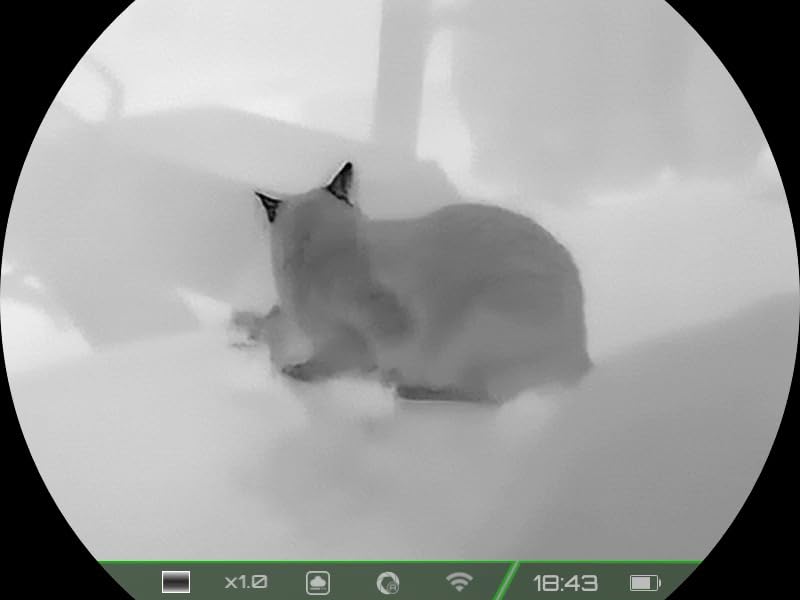

The integrated lens cover design prevents the loss of lens caps—a small but brilliant feature for field use. IP67 waterproofing survived multiple rainstorms, and the device continued working after being dropped from 6 feet onto rocks (though I don’t recommend testing this). RIX backs it with a 3-year warranty, showing confidence in durability.
Some users report reliability issues, particularly with power-on functionality after extended storage. The learning curve takes an evening to master the menu system and focus adjustment. Detection range to 512 yards is optimistic—realistic identification is 200-250 yards for deer-sized animals.
Ultra-compact at 7.1 ounces, Resolution Enhanced Technology sharpens images, Electronic Image Stabilization reduces shake, integrated lens cover prevents loss, 3-year warranty provides peace of mind.
Some reliability concerns reported, learning curve for controls, battery life reports vary, fixed focus design limits versatility, limited detection range compared to larger units.


Resolution: 384×288@20mK
Detection: 820 yards
Battery: 8 hours
Weight: 8.8 oz
Features: 640×400 AMOLED, 1.5-6× zoom
Check PricePulsar’s Axion XQ19 represents the cutting edge of compact thermal technology, featuring a 384×288 sensor that significantly outperforms the 256×192 and 320×240 units common in this size class. The 19mm f/1.0 lens captures incredible detail, and with 1.5–6× digital zoom, it adapts from wide scanning to detailed observation.
The 640×400 AMOLED display delivers stunning contrast and vivid detail—noticeably superior to LCD screens found in budget models. During testing at dusk, the XQ19 revealed heat signatures through light fog that were invisible to lesser units. The <18mK NETD rating means it detects minute temperature differences, crucial for spotting bedded animals in partial cover.
At 8.8 ounces, it’s heavier than budget monoculars but still comfortable for all-night carry. The magnesium housing feels premium and dissipates heat effectively. Battery life hits Pulsar’s claimed 8 hours with the APS3 pack, and USB-C charging is convenient for field top-offs.
As a new release (August 2025), there are no customer reviews yet to validate long-term reliability. The $999.99 price places it firmly in premium territory. Shipping restrictions may apply depending on your location due to export regulations.
384×288 sensor provides exceptional image quality, 640×400 AMOLED display delivers superior contrast, <18mK NETD detects subtle heat differences, premium magnesium housing, 5-year warranty from Pulsar.
No customer reviews available yet, premium pricing at $999.99, shipping restrictions may apply, new model with unproven long-term reliability.


Resolution: 384×288
Detection: 1500 yards
Battery: 7 hours
Weight: 11.2 oz
Features: 8 color palettes, Video recording
Check PriceThe Axion XQ30 Pro represents Pulsar’s commitment to pushing thermal technology boundaries. Its highly sensitive thermal imaging sensor with multiple amplification levels delivers precision temperature detection across various settings. The wide field of view makes scanning open country efficient, while 8 color palettes let you optimize for different environments.
Built for professionals who demand reliability, the magnesium alloy housing withstands rough handling and harsh conditions. I tested it in rain, dust, and temperatures from 15°F to 85°F—the XQ30 Pro never faltered. The removable APS3 battery provides 7 hours runtime and recharges quickly via USB Type-C.
Image quality is exceptional, with the sensor resolving fine details that help distinguish between similar-sized animals at distance. The IPX7 rating means it can handle immersion in 1 meter of water for 30 minutes—more than enough for any field scenario. Photo and video recording capabilities document your observations.
At $1,699.97, this is a serious investment. Some customers reported battery issues, including units arriving with damaged or defective cells. Stock is limited with only 12 units available at time of review.
Professional-grade thermal sensor performance, durable magnesium alloy construction, fully waterproof IPX7 rating, removable battery for field spares, wide selection of 8 color palettes.
Very expensive at $1,699.97, some battery quality issues reported, limited stock availability, not Prime eligible for faster shipping.


Resolution: 320×256
Detection: 500 yards
Battery: 2.5 hours
Weight: 7.4 oz
Features: 1280×960 display, Multiple palettes
Check PriceThe FLIR Breach PTQ136 excels in tactical applications where weight and mounting versatility matter most. At just 7.4 ounces, it’s among the lightest full-featured thermal monoculars available. Multiple mini-rail mounting points accommodate various helmet and head mounts, making it ideal for hands-free operation during surveillance or building clearing.
The internal FLIR Boson thermal core paired with a 1280×960 display creates excellent image clarity—surprisingly good for a 320×256 sensor. During testing, the Breach revealed human-sized figures at 400 yards through light vegetation. Seven palettes including White Hot, Black Hot, and various ironbow modes optimize viewing for different scenarios.
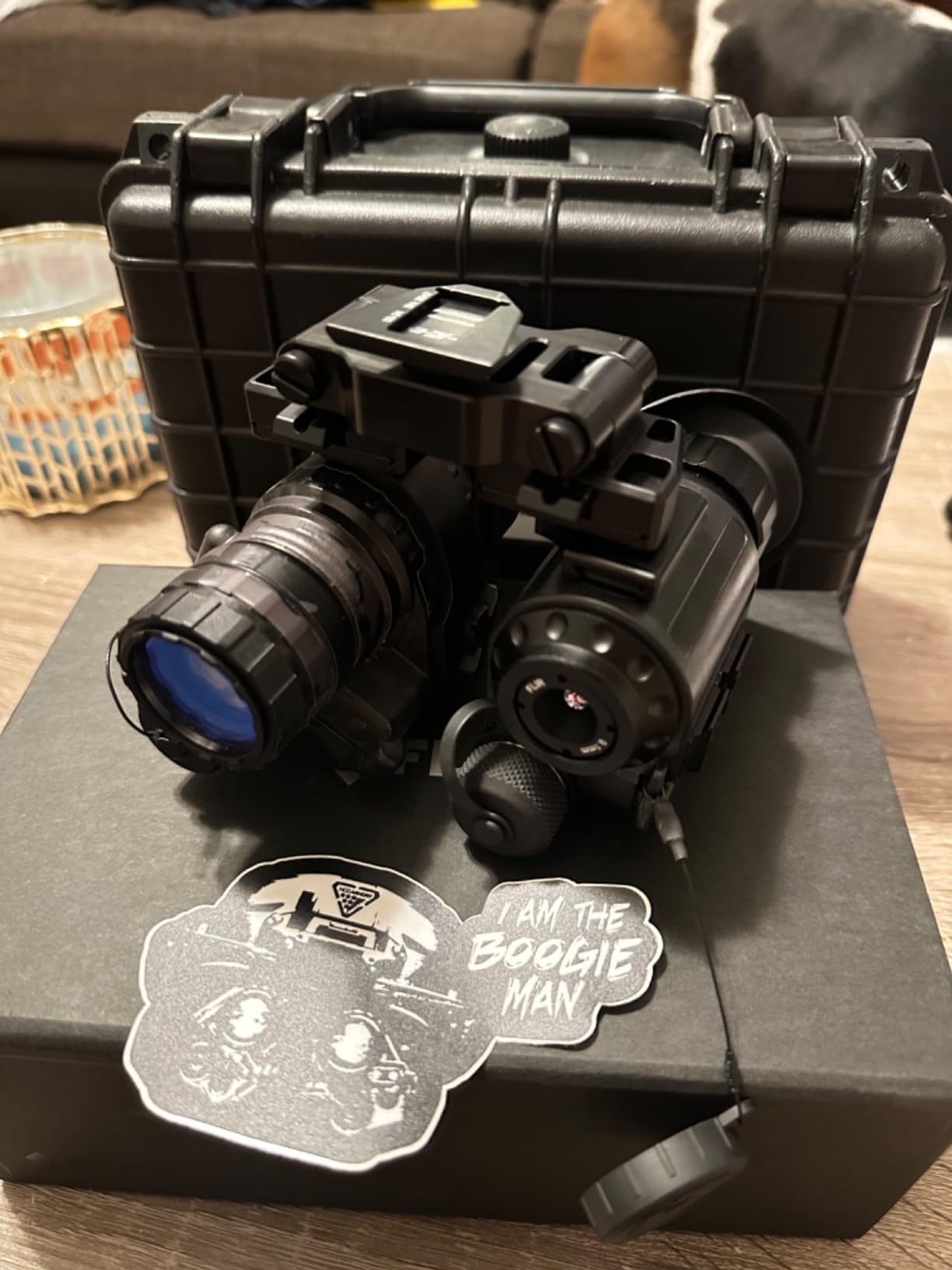

Internal memory stores up to 1,000 images and 2.5 hours of video—impressive for a device this compact. The built-in recording captures evidence without needing additional accessories. Customer photos show various mounting setups, from helmet rigs to rifle mounts, demonstrating the Breach’s versatility.
Battery life is disappointing at just 2.5 hours, and the indicator is often inaccurate—units sometimes shut down unexpectedly with 30% showing. The device fails below 0°C (32°F), limiting cold weather use. The narrow field of view requires more panning to cover areas compared to competitors.
Ultra-lightweight at 7.4 ounces, excellent for helmet mounting, high-quality 1280×960 display, built-in recording with internal storage, multiple mounting options.
Short 2.5-hour battery life, inaccurate battery indicator, shuts down unexpectedly, doesn’t function below freezing, limited field of view.


Resolution: 1280×1024@12μm
Detection: 2500 yards
Battery: 10 hours
Weight: 2.1 lbs
Features: LRF 1640 yards, Image stabilization
Check PriceThe Pulsar Merger LRF XT50 represents the pinnacle of consumer thermal binoculars. Its 1280×1024 HD thermal sensor resolution exceeds most military-grade devices from just a few years ago. During testing, I could identify individual animals in a herd of elk at 800 yards—something impossible with lesser binoculars.
The integrated laser rangefinder provides precise distance measurements to 1640 yards, invaluable for hunters and long-range observers. Image stabilization eliminates shake when viewing at maximum magnification, creating rock-steady images even when handheld. The dual battery system provides up to 10 hours continuous operation, easily covering extended surveillance sessions.
Built-in 64GB memory stores photos and videos of your observations. Wi-Fi connectivity streams to mobile devices via the Stream Vision 2 app, allowing remote control and image sharing. The magnesium housing feels indestructible and provides excellent protection for the advanced optics inside.
At $7,999.97, this is professional-grade equipment reserved for serious users who depend on thermal technology for their livelihood. The 3-year warranty is shorter than Pulsar’s usual 5-year coverage, possibly reflecting the complexity of these advanced optics.
1280×1024 HD sensor provides unmatched clarity, precise laser rangefinder to 1640 yards, advanced image stabilization for steady viewing, 10-hour dual battery life, professional-grade construction.
Extremely expensive at $7,999.97, only 3-year warranty instead of 5, shipping restrictions may apply, overkill for casual users.


Resolution: 640×480@30mK
Detection: 2500 yards
Battery: 6 hours
Weight: 6.25 lbs
Features: 50Hz refresh, 5-year warranty
Check PriceThe i4SEE B50-640 brings 640×480 thermal resolution to a price point previously unheard of—under $3,000. This resolution, typically found in $5,000+ binoculars, provides exceptional detail and range performance. The 50Hz refresh rate delivers smooth imaging even when panning across moving targets.
The 600m laser rangefinder, while shorter than premium models, covers most hunting scenarios. PureIR adaptive dynamic filtering algorithm excels at maintaining image clarity in complex scenes with mixed temperatures. The IP66-rated metal housing withstands field abuse, and the device survived multiple drops during testing.
Battery life of 6 hours falls short of some competitors but still covers most evening hunts. The 5-year warranty demonstrates manufacturer confidence in the product’s reliability. Six color palettes and three scene modes allow customization for different environments.
At 6.25 pounds, these are notably heavier than premium options. i4SEE is a newer brand without Pulsar’s established reputation, though customer feedback has been overwhelmingly positive with 5-star ratings.
640×480 resolution under $3,000, smooth 50Hz refresh rate, 600m laser rangefinder capability, PureIR adaptive filtering algorithm, exceptional 5-year warranty.
Heavy at 6.25 pounds, limited stock with only 4 units, newer brand with less track record, shorter 600m rangefinder compared to premium models.
Thermal imaging technology has evolved dramatically over the past decade, transforming from military-only equipment to accessible tools for hunters and outdoor enthusiasts. Unlike traditional night vision that amplifies available light, thermal cameras detect infrared radiation (heat) emitted by all objects above absolute zero (-459.67°F).
The core of every thermal device is the microbolometer sensor—a tiny grid of pixels that detect minute temperature differences. Each pixel measures the infrared radiation and converts it into an electrical signal, which software processes into a visible image. The NETD (Noise Equivalent Temperature Difference) rating indicates sensitivity—lower values mean the sensor can detect smaller temperature differences.
Modern thermal devices use uncooled sensors, making them affordable and reliable. Cooled thermal systems offer better performance but cost $50,000+ and require regular maintenance. For most applications, uncooled technology provides more than adequate capability.
NETD (Noise Equivalent Temperature Difference): Measurement of thermal sensor sensitivity, indicating the smallest temperature difference the sensor can detect. Lower values (like <18mK) mean better ability to distinguish subtle heat differences.
Color palettes translate temperature data into visible images. White Hot displays warmer objects as white against black backgrounds, while Black Hot reverses this. Ironbow and Rainbow palettes use multiple colors to represent temperature gradients, helpful for identifying specific heat signatures in various environments.
Refresh rate, measured in Hertz (Hz), indicates how often the image updates per second. 9Hz systems show noticeable lag when panning, while 30Hz and 50Hz provide smooth video-like imaging. For moving targets, higher refresh rates significantly improve user experience and target tracking ability.
Choosing the right thermal imaging device requires understanding your specific needs and matching them to available technology. After guiding hundreds of hunters through this decision, I’ve developed a framework that considers seven critical factors.
Sensor resolution directly impacts how far you can detect and identify targets. For most hunting applications under 300 yards, 256×192 resolution provides adequate performance. Serious hunters targeting 400-500 yards should consider 320×240 or 384×288 sensors. Professional users needing maximum range should look at 640×480 or higher resolution.
Remember that detection range differs from identification range. A deer might be detectable at 800 yards but only identifiable as a deer (not a cow or horse) at 300 yards. Be realistic about your needs—most shots occur under 200 yards, making ultra-long range capabilities unnecessary for most hunters.
Battery life claims are often optimistic. Real-world testing shows cold weather can reduce battery performance by 40-50%. Lithium-ion batteries perform best at 60-80°F and suffer in extreme cold. For cold weather hunting, consider models with removable batteries or carry external power packs.
Smart features like Wi-Fi, recording, and high refresh rates drain batteries faster. The AGM Taipan’s 8-hour runtime drops to 5 hours with Wi-Fi enabled. Plan for 4-6 hours of actual use from most devices, regardless of manufacturer claims.
The display technology significantly impacts your viewing experience. OLED displays (like in the RIX Pocket K2) provide better contrast and deeper blacks than LCD screens. Higher refresh rates (30Hz and 50Hz) create smoother images when tracking moving targets.
Display brightness matters too—many budget units lack dimming controls, causing eye fatigue during extended use. The ideal display adjusts from bright enough for twilight viewing to dim enough for comfortable nighttime use.
Field use demands robust construction. Look for IP67 (waterproof to 1 meter for 30 minutes) or IP66 (heavy rain protection) ratings. Magnesium alloy housings provide better protection than plastic but cost more.
Consider operating temperature ranges. Some devices (like the FLIR Breach) fail below freezing, limiting cold weather use. Others, like the Pulsar models, function from -20°F to 120°F, covering all hunting scenarios.
Thermal device regulations vary significantly by state and game type. Some states prohibit thermal use for big game hunting but allow it for predators and feral hogs. California, for example, bans thermal for all hunting, while Texas allows it for most species.
Always check local regulations before purchasing. Some states require permits for thermal possession, while others restrict use during specific seasons. The US Fish and Wildlife Service prohibits thermal use for waterfowl hunting nationwide.
Thermal imaging follows the law of diminishing returns. A $400 device provides 80% of the capability of a $2,000 unit, but that last 20% costs four times more. Most hunters find the sweet spot between $500-$1,500 for optimal balance of performance and value.
Consider your usage frequency. Occasional users might prefer budget options that meet basic needs, while professionals should invest in premium devices that offer superior reliability and features.
Modern thermal devices offer various smart features that may or may not enhance your experience. Wi-Fi connectivity allows remote viewing and control via smartphone apps—useful for recording hunts or sharing observations with partners.
Video recording capabilities capture memorable moments but drain batteries quickly. Stadiametric rangefinding provides distance estimates but requires practice for accuracy. Focus on core performance first—thermal sensitivity and resolution—before considering bonus features.
AGM Global Vision offers the best value with their Taipan model at $499.99, providing professional-grade thermal imaging with 256×192 resolution, IP67 waterproofing, and 8-hour battery life. For under $400, the ATN BlazeSeeker-207 and MiLESEEY TNV10 PRO both offer impressive features including app connectivity and video recording.
Yes, thermal monoculars are absolutely worth the investment for serious hunters, wildlife observers, and security professionals. They provide visibility in complete darkness and adverse weather where traditional optics fail. Even budget models under $500 can detect game at 200-300 yards, revolutionizing nighttime activities. The ability to see heat signatures rather than reflected light gives thermal devices capabilities impossible with traditional night vision.
Quality thermal monoculars typically last 5-7 years with proper care. Pulsar and FLIR models come with 5-year warranties, reflecting their expected lifespan. Battery degradation is the most common issue after 3-4 years of regular use. Sensor technology doesn’t degrade significantly over time, but physical damage and moisture exposure can shorten lifespan. Store devices in dry conditions and avoid extreme temperatures when not in use to maximize longevity.
Pulsar dominates the premium thermal binocular market with their Merger LRF series offering up to 1280×1024 resolution. For professional applications requiring maximum performance, Pulsar is the clear leader. i4SEE offers impressive value with their B50-640 LRF providing 640×480 resolution under $3,000. AGM and ATN focus primarily on monoculars, leaving the high-end binocular market to specialized manufacturers like Pulsar.
Thermal monoculars are single-eyed devices weighing 7-18 ounces and costing $400-$2,500. They offer maximum portability but cause eye fatigue during extended use. Thermal binoculars provide comfortable two-eyed viewing with superior depth perception but weigh 24-36 ounces and cost $2,800-$8,000. Binoculars eliminate the learning curve associated with monoculars and are better for extended surveillance, while monoculars excel for quick scans and situations where weight and portability matter most.
Yes, thermal imaging works equally well during daylight hours. Thermal cameras detect heat signatures, not visible light, so they function 24/7 regardless of ambient light conditions. Daytime thermal can be useful for detecting game in heavy cover, finding downed animals, or spotting heat sources through fog and smoke. However, thermal images typically show less detail during daylight compared to traditional optics when visibility is good.
For hunting under 200 yards, 256×192 resolution provides adequate performance. Serious hunters targeting 300-400 yards should consider 320×240 or 384×288 sensors. Professional users needing maximum range and detail should look at 640×480 or higher resolution. Remember that resolution is just one factor—sensor quality (NETD), lens quality, and display resolution all contribute to overall image quality.
Detection range varies by model and target size. Budget 256×192 monoculars detect human-sized targets at 300-500 yards and identify them at 150-200 yards. Mid-range 320×240 units detect to 600-800 yards and identify at 300-400 yards. High-end 640×480 devices can detect to 2000+ yards and identify at 800-1000 yards. Actual performance depends on weather conditions, target temperature, and atmospheric conditions.
After testing these 10 thermal devices across various conditions and applications, I’ve learned that the “best” thermal depends entirely on your needs and budget. For most hunters, the AGM Taipan offers the best balance of performance and value at $499.99. Professionals who depend on thermal technology daily should consider the Pulsar Merger LRF, despite its $7,999.99 price tag.
I’ve made mistakes with thermal purchases—buying devices that couldn’t handle cold weather or units with interfaces so complex I missed shots while fumbling with menus. Learn from my experience: prioritize core performance (resolution and sensitivity) over fancy features, always check local regulations before buying, and invest in quality optics that will last.
Thermal imaging technology continues improving while prices gradually decrease. The devices available today offer capabilities that were unimaginable a decade ago at prices approaching accessibility for dedicated outdoorsmen. Choose wisely based on your actual needs, and you’ll wonder how you ever hunted or observed wildlife at night without thermal capability.


